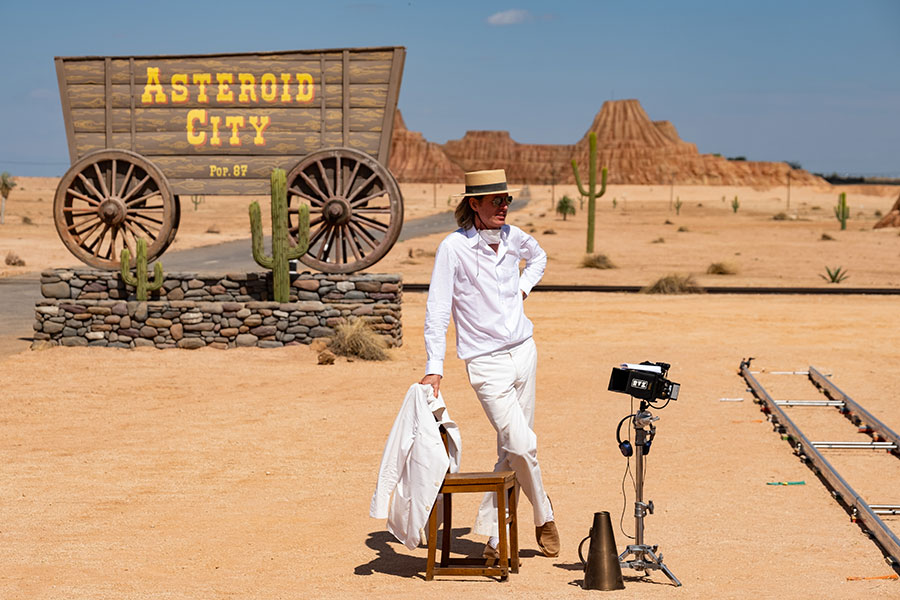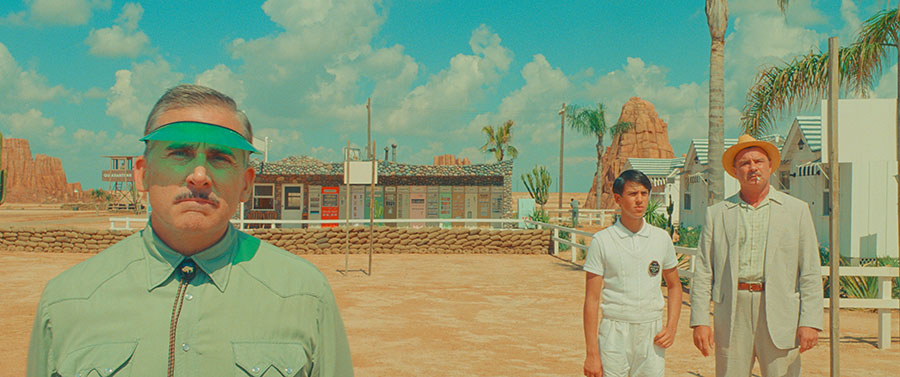Blast From the Past: ‘Asteroid City,’ ‘Oppenheimer’ and the Age of Nuclear Anxiety

Tom Hanks in director Wes Anderson's 'Asteroid City'. Photo: Courtesy of Pop. 87 Productions/Focus Features
This summer blockbuster season is about science, not superheroes, as two major movies about atoms — specifically, the atom bomb — bring nucleomituphobia, a.k.a. nuclear anxiety, back to the big screen.
Oppenheimer (in theatres July 21) is a biopic of physicist J. Robert Oppenheimer (Cillian Murphy), father of the atom bomb, in the period leading up to the world’s first nuclear explosion. The United Staes first tested the technology in 1945 at the Trinity test site in Los Alamos, New Mexico, then used it to annihilate Hiroshima and Nagasaki. Among other things, the movie probes the ethics of technological advancement.
Meanwhile, Wes Anderson’s Asteroid City (in theatres June 23) is set in tiny desert town (pop. 87) on the California/Nevada border in 1955, where a Junior Stargazers cadets convention gathers to observe Asteroid Day. The local tourist attraction, a massive crater created by a meteorite that made impact in 3007 BCE, proves to be a draw for a second interplanetary visit. The deadpan captures the era of heightened political anxiety, when worries also included the idea of Soviet missile attacks.
After the Soviet Union detonated its first nuclear device in 1949, the panic of the escalating arms race fully took hold and, by the early ’50s, civilian duck-and-cover drills were routine in schools across America; today active-shooter lockdown drills are widespread practice in school emergency plans in the less and less unlikely event of a mass shooting.
The age of anxiety has other unfortunate parallels in the present — like the very real danger of Vladimir Putin using tactical nuclear weapons. But tech pundits also compare the current moment of unleashing a new technology like generative AI on the world, to that time in the mid-1940s as humanity stepped into a new atomic age.
For his part, Oppenheimer filmmaker Christopher Nolan, 52, has been preoccupied with nukes since his teens growing up in the U.K., where the Campaign for Nuclear Disarmament was a strong presence. There’s a reference to scientist Oppenheimer in Tenet, and recall that his Batman: The Dark Knight Rises ends with the lethal neutron bomb being diverted to detonate over Gotham Bay — a weapon that originally began as a fusion reactor meant to supply the city with a source of clean energy.
Oppenheimer is based on the 2005 book American Prometheus, about the Manhattan project physicists and scientists involved in developing the atom bomb in the early ’40s. Tracing the inner moral conflicts of those directly bringing about the nuclear age and the wider implications of such technological leaps and progress — one that comes with undeniable lethal and destructive consequences — make the movie (as Nolan himself remarked in a recent Wired interview) a kind of horror movie.

Asteroid City, Aliens and Post-War Anxieties
As we now know, Roswell, New Mexico’s rumoured UFO, found and stashed by the U.S. government in the summer of 1947, was, in fact, a top secret American balloon developed to spy on the Soviet nuclear program. UFOs, in turn, became a convenient cover story for classified military programs. And from TV to toys, ’50s pop culture mined and promoted the ongoing fascination with rocket ships, interplanetary travel and alien encounters until they loomed large in the imagination.
Hollywood likewise met the moment: mass entertainment drew from the wellspring of Cold War hysteria about Russian espionage (Communists!), the threat of Soviet invasion and both nuclear annihilation and surviving an atomic attack. In a distraction from post-war paranoia directly about the atomic threat came schlocky B-movies about flying saucers, visiting aliens and Martian tales (populated by doctors and scientists both mad and heroic) that put real nuclear dangers like radiation and the aftermath of contamination into a fantastical context — helping to familiarize and normalize audiences and also to clearly define the good vs. evil dynamic. The highest-grossing movie of 1954, remember, was Them! (about giant irradiated ants) and it was swiftly followed by the likes of Creature from the Black Lagoon and Invasion of the Body Snatchers.
Characters in many of these B-movies were veterans of the Second World War protecting their new suburban families of children and young teens — the literal baby boomers.
That mood is also the undercurrent of Asteroid City. There’s war photographer Augie (Jason Schwartzman), a recent widower, and his young family, his no-nonsense father-in-law (Tom Hanks) and movie star Midge (Scarlett Johansson). The high-concept movie charts the emotional lives of these key entangled characters in the ensemble cast — all actors performing in a play within a play within a movie and whose existential crises are of a piece with the milieu of Cold War Americana.
“Something is happening where middle America has gone out into the world and they’ve come back damaged,” Anderson, 54, explains in the movie press notes. “Wounded and desperate and lost, and clashing with the country club surface the country wishes to have and protect.”

Eventually, even naturalistic movies ventured into the subject. Fred Astaire, for example, played a car-racing scientist waiting for the killing cloud to arrive in the 1959 movie On the Beach. By 1964, movies had progressed to depicting the absurdity of the Soviet standoff, with Stanley Kubrick’s genius black comedy Dr. Strangelove lampooned the irrational nature of the Cold War on the heels of the Cuban Missile Crisis.
Whether Wes Anderson’s trademark arch stylization and meticulously designed production (the object of frequent pastiche on TikTok) ultimately carries emotional heft is up to the viewer. But there’s no arguing that the art direction of Asteroid City is spot on in a way that contributes to the story.
The fictional desert town is a era-appropriate, pastel-coloured world of Bermuda pink, buttercup yellow, Capri turquoise and sherbet orange and made up of a scant collection of basic amenities: a 12-stool luncheonette, a filling station, a 10-cabin motor court hotel, a telephone booth and, improbably, a state-of-the-art government observatory.

The aspirations and anxieties of the post-war era were expressed in the look of the period. There’s the atomic influence, and not only with the widespread use of abstract atomic circle and arrow decorative motifs, swooping car fins, boomerang coffee tables and saucer-shaped buildings. Design historian Thomas Hine, who characterizes the post-war boom period between 1954 and 1964 as “one of history’s great shopping sprees,” argues that the bender of mass-produced houses, furniture and machines were inspired by a hybrid of the space age and the American frontier. In his acclaimed book Populuxe (about what underpins the look of mid-century America), Hine makes the point that many household appliance manufacturers like General Electric, Goodyear and Westinghouse were also major defence contractors. They traded on the association in their advertising of the former’s reliability and trustworthiness and linked convenience in the household and defence of the homeland.
As a result, the imagery of the push-button future is strongly tied to the military’s use of computers and the replacement of manned bombers by guided missiles — design that metabolized the threat of instant nuclear annihilation.
That craze for the convenience and the novelty of automation gets expressed in Asteroid City, for example, through the row of retro vending machines that dispense everything from coffee, candy, stockings and ammunition to a martini with a twist. The imagery of the push button went far beyond the household during the so-called populuxe years.
As Hine observed, “The President of the United States was widely viewed as having a push button on or in his desk that would trigger atomic war as surely and inexorably as a housewife could activate her dishwasher.”
RELATED:
Sun Screenings: 10 New Summer Blockbusters That Embrace Aging and Nostalgia
How the New Barbie Film Gives a Modern Update to the Classic Doll’s Nostalgia